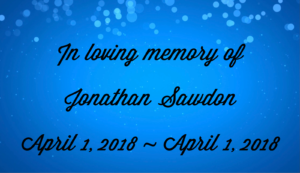family
 Every time an airplane crashes, we expect the worst…multiple deaths, if not the death of everyone on board. Some crashes look so horrific that you wonder how anyone could possibly have lived. While dropping from the sky to land on the hard ground or even on water usually ends in devastation, once in a while, a miracle happens, and everyone on the plane walks away from the crash…everyone!! It can only be called a miracle crash.
Every time an airplane crashes, we expect the worst…multiple deaths, if not the death of everyone on board. Some crashes look so horrific that you wonder how anyone could possibly have lived. While dropping from the sky to land on the hard ground or even on water usually ends in devastation, once in a while, a miracle happens, and everyone on the plane walks away from the crash…everyone!! It can only be called a miracle crash.
These days, probably the most well-known “miracle crash” was the “Miracle on the Hudson” crash. Captain Sullenberger was an amazing pilot, and as a result, all 155 people walked away from what could have been a horrible crash. Some pilots might have even tried to make it back to the airport, flying over and crashing into the city buildings, but “Sully” knew that was impossible, so he did the only sensible thing and water landed into the Hudson River.
There have been a number of other “miracle crashes” throughout the history of aviation. Some in small planes, 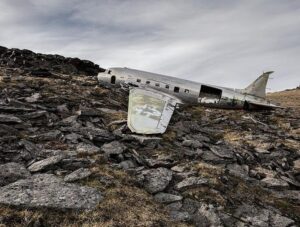 but some in large commercial planes. It may not always be possible, but a good pilot has a much better chance of landing, or really crashing their airplane and being so successful at it, that everyone walks away. The passengers are likely to have a few injuries, but they are alive, and that is what matters.
but some in large commercial planes. It may not always be possible, but a good pilot has a much better chance of landing, or really crashing their airplane and being so successful at it, that everyone walks away. The passengers are likely to have a few injuries, but they are alive, and that is what matters.
German photographer Dietmar Eckell has made it his life’s work to find, what he calls “miracles in aviation history” at the abandoned sites of wrecks that have resulted in no casualties. Eckell’s photo-project, “Happy End” highlights 15 airplanes that had forced landings, in which all the people on board survived and were rescued from really remote locations. One thing I don’t always understand is that the planes are abandoned where they crashed. I suppose sometimes it is hard to recover them, and other times they have already been there for years, by the time they are located. I never knew how many planes litter the earth, both above and below the water, but there are many.
Two of the “miracle crashes” that Eckell photographed were the Douglas Skytrain C-47 that crashed in the  Yukon in Canada in February 1950 and the Avro Shackleton, that crashed in the Western Sahara in 1994. In the crash of the Douglas Skytrain, all 10 people aboard survived, even in the frigid conditions. With the Avro Shackleton, two engines of the plane suddenly failed, sending it down to the desert sand in 1994. Surviving this crash in such an inhospitable environment was an astonishing feat for the 19 passengers and crew. If it weren’t for Dietmar Eckell’s determination to search out and photograph these lost “miracle crash” sites, much of the history of these miracles might have been forgotten. I for one plane to look up his “Happy End” project to read more about the “miracle crashes” he found.
Yukon in Canada in February 1950 and the Avro Shackleton, that crashed in the Western Sahara in 1994. In the crash of the Douglas Skytrain, all 10 people aboard survived, even in the frigid conditions. With the Avro Shackleton, two engines of the plane suddenly failed, sending it down to the desert sand in 1994. Surviving this crash in such an inhospitable environment was an astonishing feat for the 19 passengers and crew. If it weren’t for Dietmar Eckell’s determination to search out and photograph these lost “miracle crash” sites, much of the history of these miracles might have been forgotten. I for one plane to look up his “Happy End” project to read more about the “miracle crashes” he found.

 I woke up this morning to about three inches of snow, which has now turned into about twelve to fifteen inches. Spring officially started on March 20th, so my question is…WHY are we looking at so much snow!!! Businesses are closed, schools are on a homeschool day for today and tomorrow, and many of the roads are closed or have “No unnecessary travel” restrictions. I know Spring snowstorms are not that unusual, but I don’t have to like them. Ok, that’s my rant. This isn’t the first Spring snowstorm I’ve ever been through, and most likely won’t be the last. In fact, I remember a few from my childhood, that have been doozies!!
I woke up this morning to about three inches of snow, which has now turned into about twelve to fifteen inches. Spring officially started on March 20th, so my question is…WHY are we looking at so much snow!!! Businesses are closed, schools are on a homeschool day for today and tomorrow, and many of the roads are closed or have “No unnecessary travel” restrictions. I know Spring snowstorms are not that unusual, but I don’t have to like them. Ok, that’s my rant. This isn’t the first Spring snowstorm I’ve ever been through, and most likely won’t be the last. In fact, I remember a few from my childhood, that have been doozies!!
We had a storm in 1973, that totally qualifies as “a doozy” and one I’ll never forget. I had to get up on the roof of my parents’ house and shovel the snow off. The news told everyone that too much snow could cause the roof to collapse. That was the first I had ever heard of such a thing. These days, it’s common knowledge. Of course, 
 schools were closed with that storm too, and people were actually getting around on snowmobiles in town. I remember thinking ho strange that was. Still, there were people who needed to get places, and people with snowmobiles were helping them get there. I didn’t hear of any emergency childbirths with that storm, but I suppose it was possible.
schools were closed with that storm too, and people were actually getting around on snowmobiles in town. I remember thinking ho strange that was. Still, there were people who needed to get places, and people with snowmobiles were helping them get there. I didn’t hear of any emergency childbirths with that storm, but I suppose it was possible.
My niece, Chantel Balcerzak was just a teeny, little girl of two, and the snow was taller than she was. Of course, Chantel is only 4’10” now, so not much has changed, and she might want to stay indoors, so she doesn’t get lost. My dad, her grandpa, Al Spencer took her outside for a picture to commemorate the occasion. Like most snow days, the fre day presented us with a perfect opportunity for fun in the snow, and we took full advantage with snowball fights and trudging through the depths of the “white stuff” that covered the city. It’s funny how that snowstorm seemed so fun, and these days such a storm is just annoying.
I suppose things could be worse. I could be one of those 
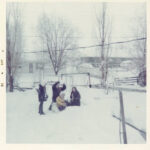 people who will lose wages due to businesses closing, or who have to figure out daycare for children who are now home from school, or who will have to figure out a way to get to work , because my job doesn’t close for snow. Since I am retired, I will just get cozy with a fire going, and watch some television…oh wait, the internet is down which means that my television, email, and internet aren’t working. Thankfully there is wi-fi, so at least there is my phone. That’s my day, I hope you all have a wonderful doozy of a snow day!!
people who will lose wages due to businesses closing, or who have to figure out daycare for children who are now home from school, or who will have to figure out a way to get to work , because my job doesn’t close for snow. Since I am retired, I will just get cozy with a fire going, and watch some television…oh wait, the internet is down which means that my television, email, and internet aren’t working. Thankfully there is wi-fi, so at least there is my phone. That’s my day, I hope you all have a wonderful doozy of a snow day!!

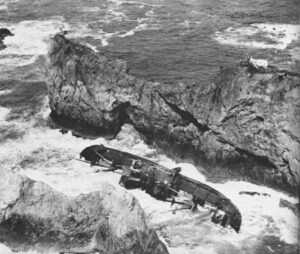 During World War II and really with any war, any coastal area of the United States had to be kept on a higher alert than during peacetime. Coastal defense networks now are much more technological that they were in 1943. During World War II, the West Coast was patrolled by units of men whose job it was to watch for activities that were out of the ordinary along the Olympic Coast of Washington. Normally, their job was pretty boring, unless you liked walking or driving along the coast looking at the ocean. There were ships out there, but most of them were where they were supposed to be and were not cause for concern.
During World War II and really with any war, any coastal area of the United States had to be kept on a higher alert than during peacetime. Coastal defense networks now are much more technological that they were in 1943. During World War II, the West Coast was patrolled by units of men whose job it was to watch for activities that were out of the ordinary along the Olympic Coast of Washington. Normally, their job was pretty boring, unless you liked walking or driving along the coast looking at the ocean. There were ships out there, but most of them were where they were supposed to be and were not cause for concern.
In the early spring of 1943, however, coastal lookout activities along the Olympic Peninsula suddenly took a turn from the mundane to something quite unusual. As the La Push unit patrolled the beach that day, they suddenly began to see debris on the beach. That is never a good thing to see, because it means that somewhere, there is a ship in a lot of trouble. Rain, wind, and heavy seas just before midnight on April 1st, were driving the Russian steamship Lamut toward the shoreline, and behind a jagged cluster of rocks just off Teahwhit Head. By the early morning hours of April 2nd, the ship was in great peril, and the lives of the crew hung in the balance.
The La Push patrol unit was in for an intense morning, as they would find at first light on April 2nd. When the 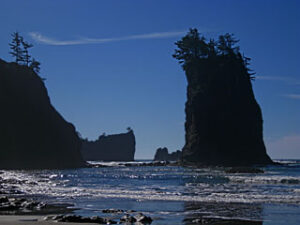 patrolmen began finding wreckage on the beach, they headed south along the beach to see if they might find the ship in trouble. It wasn’t long before they sighted part of the grounded ship. It was lodged between a hundred-foot cliff and a small, jagged rock island. Amazingly, there were survivors huddled high on the steeply sloping deck of the Russian ship called Lamut. They wouldn’t have lasted long on that deck, but the high seas made a sea rescue impossible. The coast guardsmen of the La Push Unit decided to attempt a rescue by land. That would be pretty treacherous in itself, but they had no other choice.
patrolmen began finding wreckage on the beach, they headed south along the beach to see if they might find the ship in trouble. It wasn’t long before they sighted part of the grounded ship. It was lodged between a hundred-foot cliff and a small, jagged rock island. Amazingly, there were survivors huddled high on the steeply sloping deck of the Russian ship called Lamut. They wouldn’t have lasted long on that deck, but the high seas made a sea rescue impossible. The coast guardsmen of the La Push Unit decided to attempt a rescue by land. That would be pretty treacherous in itself, but they had no other choice.
This would not be a quick rescue. By mid-morning, the members of the rescue party had cut a path through the thick underbrush bordering the beach. Then, they began their ascent along the slippery boulders to the top of the cliff above the smashed ship. They would have to get very creative in their rescue maneuvers. “Using gauze bandage weighted with a rock, a light line was lowered to the eager hands of the stranded crew aboard the Lamut. Tying heavier line to the gauze, one line succeeded another until a lifeline strong enough to support the weight of a single person was stretched between the ship and the cliff. One by one survivors were raised to the cliff top and finally assisted down the landward side of the rocky ridge to the beach below. As darkness approached, the last of the Lamut survivors emerged from the swampy beach trail to waiting coast guard trucks and ambulances.” The rescue of the Lamut crew was among the most dramatic events in the annals of World War II beach patrol history.
While this was just one of the rescues conducted by the Olympic Defense Network, it was undoubtedly the most intense rescue they performed in their years of service. On March 29, 1944, the beach patrol ended and a week 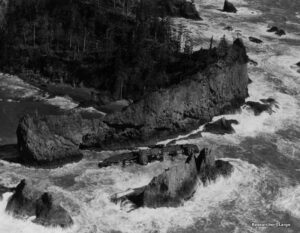
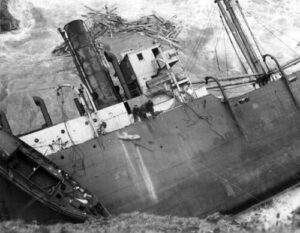 later the unit decommissioned. The trails in that area are now a part of the Olympic National Park probably date from the era of World War II beach patrol activities. A while back, a small, collapsed wood frame cabin was located at Teahwhit Head. It is believed to be associated with World War II beach patrolling activities in the La Push unit, and quite possibly belongs to the Lamut.
later the unit decommissioned. The trails in that area are now a part of the Olympic National Park probably date from the era of World War II beach patrol activities. A while back, a small, collapsed wood frame cabin was located at Teahwhit Head. It is believed to be associated with World War II beach patrolling activities in the La Push unit, and quite possibly belongs to the Lamut.
 Every year, maybe simply because Winter can be so depressing, just a little way into Spring, we have a day for fun. If you didn’t know, the day is called April Fool’s Day. Some like the day, others kind of hate it, and some don’t care one way or the other. Still, I think most people give the day a try, at least. As a kid, we tried to pull off the best prank ever, but depending on our age at the time, we often failed miserably. You can only tell someone there is a spider on their head so many times on April Fool’s Day, before they simply stop believing your story.
Every year, maybe simply because Winter can be so depressing, just a little way into Spring, we have a day for fun. If you didn’t know, the day is called April Fool’s Day. Some like the day, others kind of hate it, and some don’t care one way or the other. Still, I think most people give the day a try, at least. As a kid, we tried to pull off the best prank ever, but depending on our age at the time, we often failed miserably. You can only tell someone there is a spider on their head so many times on April Fool’s Day, before they simply stop believing your story.
My parents, Al and Collene Spencer, were pretty good at April Fool’s Day pranks. I remember putting sugar on chicken and salt on cereal. I suppose some people would get upset about that, but we all had a good sense of humor, and found it to be a good  laugh. Of course, there are hundreds of other pranks that can be played on people, and some of them are very elaborate. I guess it just depends on the level of imagination you have, and how far you are willing to play your prank out. For some people, April Fool’s Day just isn’t enough, and they become Bonafide Pranksters, ready to prank their next victim at any given moment. Their pranks might happen at any time on any day, which can also be very funny.
laugh. Of course, there are hundreds of other pranks that can be played on people, and some of them are very elaborate. I guess it just depends on the level of imagination you have, and how far you are willing to play your prank out. For some people, April Fool’s Day just isn’t enough, and they become Bonafide Pranksters, ready to prank their next victim at any given moment. Their pranks might happen at any time on any day, which can also be very funny.
April Fool’s Day has always seemed to me as the real beginning of Spring, even though Spring officially begins on March 20th, the weather then is usually so windy and cold here in Wyoming, that I just don’t really think much about Spring until April Fool’s Day. Then, there is usually more chance of temperatures in at least the  40s, so I can actually envision Spring flowers. Whether I choose to play any pranks or not, doesn’t matter as much to me as the distinct prospect of the coming Spring. I am more of a late Spring or Summer girl, but if it’s a choice of Winter or Spring, I’ll take Spring every time…and I truly love Spring flowers.
40s, so I can actually envision Spring flowers. Whether I choose to play any pranks or not, doesn’t matter as much to me as the distinct prospect of the coming Spring. I am more of a late Spring or Summer girl, but if it’s a choice of Winter or Spring, I’ll take Spring every time…and I truly love Spring flowers.
If you decide to prank, I hope you are successful in your pranks, without anyone getting mad at you. And if you don’t decide to prank, well sometimes it’s more fun to watch other people get pranked, as long as no one notices that you are sitting quietly by without a prank in sight, because if they notice you, you are very likely is big trouble. Happy April Fool’s Day everyone. Have fun!!

 My niece, Elizabeth “Liz” Masterson is a remarkable woman, and you will hear the same statement from anyone who knows her. Liz is a journalism teacher at Kelly Walsh High School and has been teaching since 2004…first at Natrona County High School, and then back to her Alma Mater…Kelly Walsh High School. She is a favorite among her students and stays in touch with many of them. They all truly love her, and every so often, Liz hears a story about herself from fellow teachers and students, that takes her by surprise, because Liz is not one to “toot her own horn” or even to realize how amazing she is.
My niece, Elizabeth “Liz” Masterson is a remarkable woman, and you will hear the same statement from anyone who knows her. Liz is a journalism teacher at Kelly Walsh High School and has been teaching since 2004…first at Natrona County High School, and then back to her Alma Mater…Kelly Walsh High School. She is a favorite among her students and stays in touch with many of them. They all truly love her, and every so often, Liz hears a story about herself from fellow teachers and students, that takes her by surprise, because Liz is not one to “toot her own horn” or even to realize how amazing she is.
While Elizabeth was at dinner the other night with two of her teacher friends, one told her that she had overheard two of her students talking about Elizabeth, and “how great she is!” Being the very down-to-earth person she is, Elizabeth is always surprised and shocked to hear this kind of thing. It’s a compliment, but it embarrasses her a little, too. The teacher heard a teenage girl tell the guy she was talking with that she had just been introduced to “Ms. Mast” (the name the students have given her over the years) so that Elizabeth could give her a little help on a project, and that it was literally like she had experienced a “celebrity encounter!” These were the student’s own words. This was the, albeit “dramatic,” conversation overheard by a teacher, between two kids talking to each other, but these were this young lady’s feelings.
What my sister, Cheryl Masterson, who is Liz’s mom, so enjoyed about this “celebrity encounter” story is that it is not only hilarious, but also sweet. In the family, we have all been impressed with Liz’s ability to connect with and mentor her students, but seeing it through the eyes of a young lady who had only known OF Elizabeth before…a young lady who was very pleased that she was now able to actually know her…a young lady who had entered “Elizabeth’s circle,” so to speak, was well…awe inspiring. It’s a very small thing in the world of life events, but for this young lady…she knew that she had experienced a “celebrity encounter” and it made her 
 day! In fact, the event so impressed her, that she and her friend were still talking about it when they got to this teacher’s classroom!
day! In fact, the event so impressed her, that she and her friend were still talking about it when they got to this teacher’s classroom!
Cheryl is certain that Elizabeth’s friend laughingly, and lovingly, rolled her eyes, but still it was very endearing for her, as Elizabeth’s good friend, to hear, and to pass such a sweet story to Elizabeth. As the journalism teacher, who also creates the school newspaper and the school yearbook with her students, Elizabeth tirelessly attends nearly every single function and school event the school has. All sports events, all dances, all activities of any kind. She takes pictures of all the events, and of all the kids at these events, and she gives all that she has to these students all school year long. The students and parents see it and appreciate it! Truly, Elizabeth is a fixture at her school. She is chosen almost every single year by some student as their favorite and most influential teacher, and recognized for that, among other teachers, at a special dinner the schools have, every year. Whether she knows all the kids or not, they ALL know her! She has a reputation among the students as being salty, sassy, and no-nonsensical, but a lot of fun to be around, and they learn a lot from her! She is one of a kind! She is blessed and she is a blessing to others.
Elizabeth’s students often go on to great things, but some stand out just a little bit more than others, like Meagan Degenfelder, who was just elected as Wyoming’s Superintendent of Public Instruction. It was a proud moment for Elizabeth, as her former teacher too, and she was invited to attend the inauguration, and also had the opportunity to meet Wyoming’s Governor Mark Gordon at the inauguration gala.
Liz loves teaching and all her students, but she is also a well-rounded person. She loves going to concerts, and has attended approximately ten with her sister, Jenny, but Liz has attended hundreds more with friends, students, and her other sisters. She is a great aunt, who has taken nieces and nephews to movies and games, and 

 has showed up for them on their birthdays and all accomplishments. She is an amazing mentor for her nieces and nephews as well. Liz not only teaches young people how to be successful in all they do, but she lives what she teaches too. Today is Liz’s birthday. Happy birthday Liz!! Have a great day!! We love you and we are very proud of you!!
has showed up for them on their birthdays and all accomplishments. She is an amazing mentor for her nieces and nephews as well. Liz not only teaches young people how to be successful in all they do, but she lives what she teaches too. Today is Liz’s birthday. Happy birthday Liz!! Have a great day!! We love you and we are very proud of you!!
 If King George III was hoping to keep the New England colonies dependent on the British by placing taxes, restrictions, lockdowns, and the New England Restraining Act on them, he greatly underestimated the colonists. The New England Restraining Act was endorsed by King George III on March 30, 1775. The Act required New England colonies to trade exclusively with Great Britain as of July 1, 1775, with an additional rule going into effect on July 20, banning colonists from fishing in the North Atlantic.
If King George III was hoping to keep the New England colonies dependent on the British by placing taxes, restrictions, lockdowns, and the New England Restraining Act on them, he greatly underestimated the colonists. The New England Restraining Act was endorsed by King George III on March 30, 1775. The Act required New England colonies to trade exclusively with Great Britain as of July 1, 1775, with an additional rule going into effect on July 20, banning colonists from fishing in the North Atlantic.
The Restraining Act and the Conciliatory Proposition were introduced to Parliament by British prime minister, Frederick, Lord North, on the same day. The Conciliatory Proposition promised that no colony that met its share of imperial defenses and paid royal officials’ salaries of their own accord would be taxed…a ridiculous statement, because the very act of making the forced payments was basically taxing. Supposedly, the British were  conceding to the colonists’ demand that they be “allowed to provide the crown with needed funds on a voluntary basis.” Through the preposition, Parliament would ask for money through requisitions, not demand it through taxes. If you ask me, that is a distinction without a difference. Either way, the colonists were forced to pay for things they shouldn’t have to. The Restraining Act was meant to appease Parliamentary hardliners, who would otherwise have impeded passage of the pacifying proposition. So, Lord North had to work both sides against the middle to get the Conciliatory Proposition passed.
conceding to the colonists’ demand that they be “allowed to provide the crown with needed funds on a voluntary basis.” Through the preposition, Parliament would ask for money through requisitions, not demand it through taxes. If you ask me, that is a distinction without a difference. Either way, the colonists were forced to pay for things they shouldn’t have to. The Restraining Act was meant to appease Parliamentary hardliners, who would otherwise have impeded passage of the pacifying proposition. So, Lord North had to work both sides against the middle to get the Conciliatory Proposition passed.
Unfortunately for North and prospects for peace, General Thomas Gage had already received orders from London to march on Concord, Massachusetts. His orders were to destroy the armaments stockpiled in the town and take Patriot leaders John Hancock and Samuel Adams into custody. Gage had received the orders in January 1775 and arrived in Boston before the Conciliatory Proposition, meaning that he didn’t know about the  agreement made to stop the taxing of the colonists. So, on April 18, 1775, an army of 700 Redcoats marched towards Concord Bridge. It was basically the last straw…the military action that would lead to the Revolutionary War, the birth of the United States as a new nation, the temporary downfall of Lord North, and the near abdication of King George III. The Treaty of Paris marked the end of the conflict and guaranteed New Englanders the right to fish off Newfoundland. It was the very right denied them by the New England Restraining Act. The British learned that they could only push the colonists so far, and then they would lose control of the very people they tried to enslave.
agreement made to stop the taxing of the colonists. So, on April 18, 1775, an army of 700 Redcoats marched towards Concord Bridge. It was basically the last straw…the military action that would lead to the Revolutionary War, the birth of the United States as a new nation, the temporary downfall of Lord North, and the near abdication of King George III. The Treaty of Paris marked the end of the conflict and guaranteed New Englanders the right to fish off Newfoundland. It was the very right denied them by the New England Restraining Act. The British learned that they could only push the colonists so far, and then they would lose control of the very people they tried to enslave.
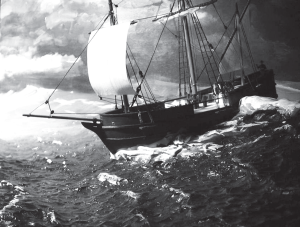 The dangers of the Cape Cod shoals are well known to the seamen who regularly navigate those waters. Almost from the time the shoals were discovered, they have been wreaking havoc on the ships that have the misfortune of getting too close to them. Sailors know that they need to steer clear of the Cape coast. Thousands of ships have been destroyed on its bars and rocks, and with the lost ships, uncounted lives too have been lost in the storm-tossed waves. When the storms were raging and a ship got caught, there was no way for rescuers to get to the trapped crew and passengers. The storms battered the trapped ships until they sank.
The dangers of the Cape Cod shoals are well known to the seamen who regularly navigate those waters. Almost from the time the shoals were discovered, they have been wreaking havoc on the ships that have the misfortune of getting too close to them. Sailors know that they need to steer clear of the Cape coast. Thousands of ships have been destroyed on its bars and rocks, and with the lost ships, uncounted lives too have been lost in the storm-tossed waves. When the storms were raging and a ship got caught, there was no way for rescuers to get to the trapped crew and passengers. The storms battered the trapped ships until they sank.
Oddly, Cape Cod is both a hazard and a haven to the mariners. All shipping between Boston and New York must either pass into its sheltered bay or run aground on its treacherous shoals. It is only the skill of the mariners that determines the difference. The shoals, when combined with the forces of 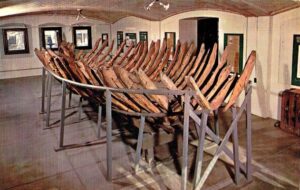 countless Nor’easters put the Cape in a precarious location. Because of this, the Cape has been the site of more than 3,000 shipwrecks in 300 years of recorded history.
countless Nor’easters put the Cape in a precarious location. Because of this, the Cape has been the site of more than 3,000 shipwrecks in 300 years of recorded history.
One of the first recorded wrecks was that of the Sparrow Hawk. The Sparrow Hawk originally hailed from London, England. It was making a six-week voyage to Virginia when it ran aground off Nauset Harbor in 1626. A gale arose and forced the vessel over the bar into the harbor. The ship ran aground near Orleans. The area isn’t always so dangerous. When the tide is low, people aboard the ships were able to get ashore safely when their ships ran aground. When Sparrow Hawk grounded, some English-speaking Indians arrived and offered to conduct them to Plymouth or carry a message. Grateful, they accepted and once ashore, they sent a message which brought Governor William Bradford with repair material. The ship was soon repaired, but before it could set sail, the ship was sunk by another storm. The sunken ship was abandoned.
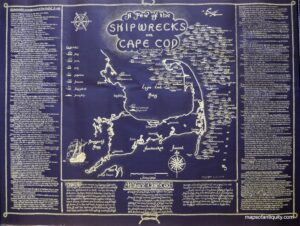
The second wreck would be more permanent, as the ship wasn’t seen for over 200 years. The wreckage reappeared on May 6, 1863, after the sand shifted. The exposed remains of the ship reappeared only briefly. Because of the vessel’s unusual shape, two local men made a drawing of it. The ship was an oddity, and it drew many visitors. The visitors, when they came to see, nearly all took a fragment of the ship for a souvenir before it was again covered by sand in August of 1863. Since they now knew where the ship was, it has since been excavated, and the ribs of the ship were removed and transferred to the Pilgrim Hall Museum in Plymouth, where it is to this day.
 In any war, there must be a nation’s first casualty. World War I could be no different. On March 28, 1915, the first American citizen was killed in the eighth month of World War I. The United States didn’t even enter the war until April 6, 1917. Nevertheless, Leon Thrasher, who was a 31-year-old mining engineer and a native of Massachusetts, drowned when a German U-Boat, the U-28 torpedoed a cargo-passenger ship the British RMS Falaba, a West African steamship, on which Thrasher was a passenger. The sinking became known as “The Thrasher Incident.” The RMS Falaba was on its way from Liverpool to West Africa, off the coast of England. Of the 242 passengers and crew on board RMS Falaba, 104 drowned. Thrasher was employed on the Gold Coast in British West Africa, and on March 28, 1915, he was on the RMS Falaba, as a passenger, returning to his post, following a trip to England.
In any war, there must be a nation’s first casualty. World War I could be no different. On March 28, 1915, the first American citizen was killed in the eighth month of World War I. The United States didn’t even enter the war until April 6, 1917. Nevertheless, Leon Thrasher, who was a 31-year-old mining engineer and a native of Massachusetts, drowned when a German U-Boat, the U-28 torpedoed a cargo-passenger ship the British RMS Falaba, a West African steamship, on which Thrasher was a passenger. The sinking became known as “The Thrasher Incident.” The RMS Falaba was on its way from Liverpool to West Africa, off the coast of England. Of the 242 passengers and crew on board RMS Falaba, 104 drowned. Thrasher was employed on the Gold Coast in British West Africa, and on March 28, 1915, he was on the RMS Falaba, as a passenger, returning to his post, following a trip to England.
The sinking, brought with it a claim from the Germans that the submarine’s crew had 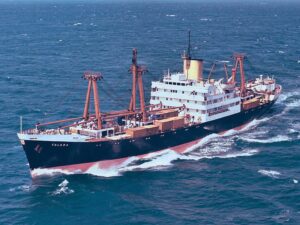 followed all protocol when approaching RMS Falaba. The Germans said that they gave the passengers ample time to abandon ship, and that they fired only when British torpedo destroyers began to approach to give aid to the Falaba. Of course, the British official press report of the incident disagreed, claiming that the Germans had acted improperly, “It is not true that sufficient time was given the passengers and the crew of this vessel to escape. The German submarine closed in on the Falaba, ascertained her name, signaled her to stop, and gave
followed all protocol when approaching RMS Falaba. The Germans said that they gave the passengers ample time to abandon ship, and that they fired only when British torpedo destroyers began to approach to give aid to the Falaba. Of course, the British official press report of the incident disagreed, claiming that the Germans had acted improperly, “It is not true that sufficient time was given the passengers and the crew of this vessel to escape. The German submarine closed in on the Falaba, ascertained her name, signaled her to stop, and gave 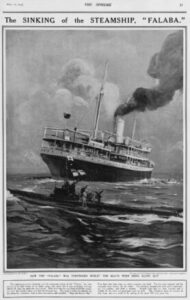 those on board five minutes to take to the boats. It would have been nothing short of a miracle if all the passengers and crew of a big liner had been able to take to their boats within the time allotted.”
those on board five minutes to take to the boats. It would have been nothing short of a miracle if all the passengers and crew of a big liner had been able to take to their boats within the time allotted.”
The sinking of RMS Falaba, and Thrasher’s subsequent death, was mentioned again in a memorandum sent by the US government, which was drafted by President Woodrow Wilson himself and addressed to the German government after the German submarine attack on the British passenger ship Lusitania on May 7, 1915, in which 1,201 people were drowned, including 128 Americans. President Wilson’s note was clearly a warning, calling for the US and Germany to come to a full and complete understanding as to the grave situation which had resulted from the German policy of unrestricted submarine warfare. In response to the warning, Germany abandoned the policy shortly thereafter. However, the policy abandonment was reversed in early 1917, and that was the final straw that put the United States into World War I on April 6, 1917.

 This year has been one of so much change for my niece, Amanda Reed. The biggest change is that Jadyn Mortensen, the daughter that she shares with partner, Sean Mortensen went away to college. It wasn’t that she was so far away, but because she is their only child, her leaving brought not only their first college student, but also the empty nest syndrome. They are a very close family. They all share a love of all things outdoor sports. Jadyn is even attending the University of Wyoming on a full ride rodeo scholarship. From boating, to snowmobiling, to skiing, to motorcycling, to horse riding, this is a family of athletes, and they do it all together. So having Jadyn in college, leaves a big hole in the family dynamic, and they are all feeling it. The good news is that summer is coming, and Jadyn’s break from college.
This year has been one of so much change for my niece, Amanda Reed. The biggest change is that Jadyn Mortensen, the daughter that she shares with partner, Sean Mortensen went away to college. It wasn’t that she was so far away, but because she is their only child, her leaving brought not only their first college student, but also the empty nest syndrome. They are a very close family. They all share a love of all things outdoor sports. Jadyn is even attending the University of Wyoming on a full ride rodeo scholarship. From boating, to snowmobiling, to skiing, to motorcycling, to horse riding, this is a family of athletes, and they do it all together. So having Jadyn in college, leaves a big hole in the family dynamic, and they are all feeling it. The good news is that summer is coming, and Jadyn’s break from college. 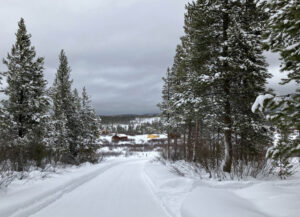
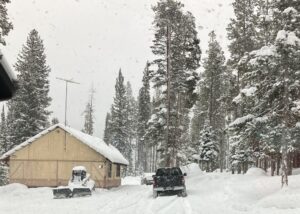
Amanda and Sean decided to buy his parents cabin at Ryan Park, and the area is just beautiful. Ryan Park is in the Snowy Range, and the area is surrounded by trees and nature. They spent last Christmas up there. Everyone who joined them had a wonderful time. The cabin will be a wonderful addition to their many outdoor activities, both for summer and winter use. A cabin in the mountains is always a beautiful spot to spend time. I know they will really enjoy their time there.
Amanda has been working in the banking industry for all of her adult life, and she has made great strides in her field. Amanda went to work at the Rawlins National Bank at a young age and worked her way up to the pretty 
 prestigious position of BSA Agent, which is a part of the law enforcement area of the bank. Now, she has been promoted to Vice President over operations, which is a wonderful step up. She’s very happy about that! Amanda has worked so hard to advance her career, and she has been so successful in everything she does. This latest promotion is such a big one for her, and we are all so proud of this accomplishment. I know that the future will continue to be amazing for Amanda. It seems that every time she turns around, there is another great change waiting for her. She is such an engaging person, and always wears a smile. She has a great group of friends that, along with her family, round out her world very nicely. Today is Amanda’s birthday. Happy birthday Amanda!! Have a great day!! We love you!!
prestigious position of BSA Agent, which is a part of the law enforcement area of the bank. Now, she has been promoted to Vice President over operations, which is a wonderful step up. She’s very happy about that! Amanda has worked so hard to advance her career, and she has been so successful in everything she does. This latest promotion is such a big one for her, and we are all so proud of this accomplishment. I know that the future will continue to be amazing for Amanda. It seems that every time she turns around, there is another great change waiting for her. She is such an engaging person, and always wears a smile. She has a great group of friends that, along with her family, round out her world very nicely. Today is Amanda’s birthday. Happy birthday Amanda!! Have a great day!! We love you!!
